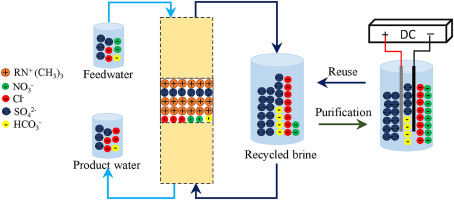当前位置:
X-MOL 学术
›
Water Res.
›
论文详情
Our official English website, www.x-mol.net, welcomes your feedback! (Note: you will need to create a separate account there.)
Achieving low-cost, highly selective nitrate removal with standard anion exchange resin by tuning recycled brine composition.
Water Research ( IF 12.8 ) Pub Date : 2020-01-31 , DOI: 10.1016/j.watres.2020.115571 Shoupeng Duan 1 , Tiezheng Tong 2 , Shaokui Zheng 1 , Xueyu Zhang 1 , Shida Li 1
Water Research ( IF 12.8 ) Pub Date : 2020-01-31 , DOI: 10.1016/j.watres.2020.115571 Shoupeng Duan 1 , Tiezheng Tong 2 , Shaokui Zheng 1 , Xueyu Zhang 1 , Shida Li 1
Affiliation

|
This study demonstrated the presence of a critical equivalent ratio of the competing anion (i.e., sulfate and bicarbonate) to chloride ion in recycled brine to achieve highly-selective nitrate removal from nitrate-rich groundwater in the standard-anion exchange resin (AER) (i.e., with trimethylamine functional groups) column process. With increasing bicarbonate (or sulfate):chloride equivalent ratio in brine used to circularly activate/regenerate the standard-AER column, considerable bicarbonate (sulfate) removal and dumping were observed. The critical bicarbonate (sulfate):chloride equivalent ratio of 2:5 (8:1) in brine effectively achieved zero net bicarbonate (sulfate) removal (<5%) from feedwater during long-term exhaustion-regeneration cyclic operation. The feed rate (6-18 BV/h) played a key role in determining the critical sulfate:chloride equivalent ratio in brine, while the feed sulfate concentration (145-345 mg/L) slightly changed the critical sulfate:chloride equivalent ratio. The use of optimized ternary brine (with a sulfate:chloride:bicarbonate equivalent ratio of 42:5:2) stably achieved long-term highly-selective nitrate removal from groundwater in the standard-AER column process with brine electrochemical treatment. The possible mechanism for nitrate selectivity included the modification of the sulfate: and bicarbonate:chloride equivalent ratios in the standard-AER column by the optimized brine in circular activation/regeneration mode; this changed the column elution and breakthrough curves, inhibited the competition of sulfate and bicarbonate for ion exchange sites during exhaustion according to the separation factor, and finally achieved selective nitrate removal from feedwater.
中文翻译:

通过调整回收的盐水成分,使用标准的阴离子交换树脂实现低成本,高选择性的硝酸盐去除。
这项研究证明了在循环盐水中存在竞争性阴离子(即硫酸根和碳酸氢根)与氯离子的临界当量比,以实现从标准阴离子交换树脂(AER)中富含硝酸盐的地下水中高选择性硝酸盐的去除(即具有三甲胺官能团)的柱工艺。随着用于循环活化/再生标准AER柱的盐水中碳酸氢盐(或硫酸盐):氯化物当量比的增加,观察到大量的碳酸氢盐(硫酸盐)去除和倾倒。盐水中的临界碳酸氢盐(硫酸盐):氯化物当量比为2:5(8:1),在长期的排气-再生循环运行过程中,有效地实现了自给水中零净碳酸氢盐(硫酸盐)去除(<5%)。进料速度(6-18 BV / h)在确定临界硫酸盐方面起着关键作用:盐水中氯化物当量比,而进料硫酸盐浓度(145-345 mg / L)稍微改变了临界硫酸盐:氯化物当量比。使用优化的三元盐水(硫酸盐:氯化物:碳酸氢盐当量比为42:5:2)稳定地实现了在标准AER柱工艺中通过盐水电化学处理从地下水中长期高选择性去除硝酸盐的能力。硝酸盐选择性的可能机制包括通过优化的盐水在循环活化/再生模式下改变标准AER柱中硫酸盐:和碳酸氢盐:氯化物的当量比;这改变了色谱柱的洗脱和突破曲线,根据分离因子抑制了硫酸根和碳酸氢根在耗尽过程中对离子交换位的竞争,
更新日期:2020-01-31
中文翻译:

通过调整回收的盐水成分,使用标准的阴离子交换树脂实现低成本,高选择性的硝酸盐去除。
这项研究证明了在循环盐水中存在竞争性阴离子(即硫酸根和碳酸氢根)与氯离子的临界当量比,以实现从标准阴离子交换树脂(AER)中富含硝酸盐的地下水中高选择性硝酸盐的去除(即具有三甲胺官能团)的柱工艺。随着用于循环活化/再生标准AER柱的盐水中碳酸氢盐(或硫酸盐):氯化物当量比的增加,观察到大量的碳酸氢盐(硫酸盐)去除和倾倒。盐水中的临界碳酸氢盐(硫酸盐):氯化物当量比为2:5(8:1),在长期的排气-再生循环运行过程中,有效地实现了自给水中零净碳酸氢盐(硫酸盐)去除(<5%)。进料速度(6-18 BV / h)在确定临界硫酸盐方面起着关键作用:盐水中氯化物当量比,而进料硫酸盐浓度(145-345 mg / L)稍微改变了临界硫酸盐:氯化物当量比。使用优化的三元盐水(硫酸盐:氯化物:碳酸氢盐当量比为42:5:2)稳定地实现了在标准AER柱工艺中通过盐水电化学处理从地下水中长期高选择性去除硝酸盐的能力。硝酸盐选择性的可能机制包括通过优化的盐水在循环活化/再生模式下改变标准AER柱中硫酸盐:和碳酸氢盐:氯化物的当量比;这改变了色谱柱的洗脱和突破曲线,根据分离因子抑制了硫酸根和碳酸氢根在耗尽过程中对离子交换位的竞争,



























 京公网安备 11010802027423号
京公网安备 11010802027423号